engine coolant SKODA SUPERB 2007 1.G / (B5/3U) User Guide
[x] Cancel search | Manufacturer: SKODA, Model Year: 2007, Model line: SUPERB, Model: SKODA SUPERB 2007 1.G / (B5/3U)Pages: 259, PDF Size: 14.71 MB
Page 171 of 259

Towing a trailer
170
should be attached to folding arms. Adjust the mirrors so that they provide you with
an adequate field of view to the rear.
Headlights
Before starting off with a hitched trailer, also check the setting of the headlights.
Alter the setting as necessary with the aid of the headlight beam adjuster
⇒ page 48.
Detachable ball head
The ball rod is detachable on vehicles wh ich feature a factory-fitted towing device.
It is stowed together with separate fitting instructions in the spare wheel well in the
luggage compartment of the vehicle.
Further information on the towing device ⇒page 171.
Note
•We recommend that you also have yo ur vehicle inspected between service
intervals if you tow a trailer frequently.
•The handbrake on the towing vehicle must be put on when coupling and
decoupling the trailer.
Driving Tips
Particular caution is required when towing a trailer.
– Do not, as far as possible, drive with your vehicle unladen and the
trailer laden.
– Do not make full use of the legal maximum speeds. This applies in
particular to downhill sections.
– Apply the brakes in good time.
– Keep a check on the coolant temper ature gauge if the outside temper-
ature is high.
Distribution of weight
The distribution of the weight is very poor if your vehicle is unladen and the trailer
is laden. Maintain a particularly low speed if you cannot avoid driving with this
combination.
Driving speed
Do not drive faster than 80 km/h for safety reasons. This also applies for countries
in which higher speeds are allowed.
The fact that the driving stability of the vehicle + trailer combination reduces with
increasing speed means that the legally allowed speed should not be used when
there are unfavourable road, weather or wind conditions, particularly near accident
black spots.
You must always reduce your speed immedi ately as soon as you detect even just
the slightest swaying of the trailer. On no account attempt to stop the trailer from
“swaying” by accelerating.
Apply the brakes in good time! If the trailer is fitted with a trailer brake, apply the
brakes gently at first and then brake firmly. This will avoid brake jolts resulting from
the trailer wheels locking. Shift down gears in good time before negotiating a down-
hill section to allow the engine to also act as a brake.
Engine overheating
Please keep a check on the coolant temperature gauge if you have to negotiate a
lengthy slope in a low gear at a high engi ne speed when the outside temperature is
very high ⇒page 12.
If the needle of the coolant temperature gauge moves into the right-hand area or
even the red area of the scale, reduce yo ur speed immediately. Stop and switch off
the engine if the warning light
in the instrument cluste r begins flashing. Wait a
few minutes and check the level of coolant in the coolant expansion bottle
⇒ page 190, “Inspecting the coolant level”.
Please refer to the following guidelines ⇒page 26, “Coolant temperature, Coolant
quantity ”.
The coolant temperature can be reduced by switching on the heating.
Any increase in the cooling effect of the coolant fan through shifting down a gear
and increasing the engine speed is not possible since the fan speed is independent
NKO B5 20.book Page 170 Friday, March 2, 2007 1:46 PM
Page 186 of 259
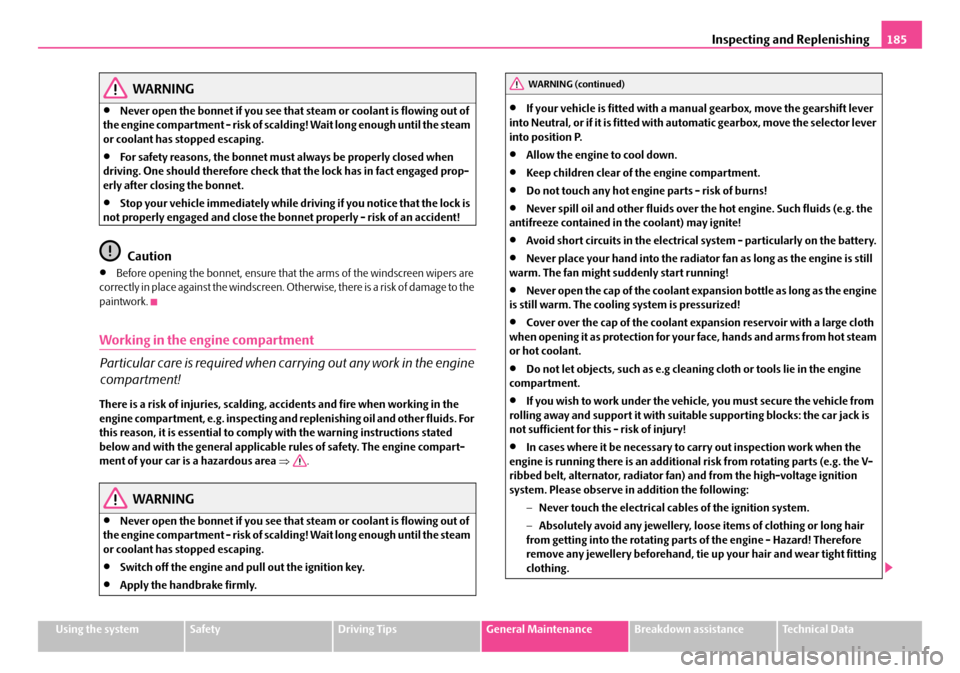
Inspecting and Replenishing185
Using the systemSafetyDriving TipsGeneral MaintenanceBreakdown assistanceTechnical Data
WARNING
•Never open the bonnet if you see that steam or coolant is flowing out of
the engine compartment - risk of scaldi ng! Wait long enough until the steam
or coolant has stopped escaping.
•For safety reasons, the bonnet must always be properly closed when
driving. One should therefore check that the lock has in fact engaged prop-
erly after closing the bonnet.
•Stop your vehicle immediately while driv ing if you notice that the lock is
not properly engaged and close the bonne t properly - risk of an accident!
Caution
•Before opening the bonnet, ensure that the arms of the windscreen wipers are
correctly in place against the windscreen. Otherwise, there is a risk of damage to the
paintwork.
Working in the engine compartment
Particular care is required when carrying out any work in the engine
compartment!
There is a risk of injuries, scalding, accidents and fire when working in the
engine compartment, e.g. inspecting and replenishing oil and other fluids. For
this reason, it is essential to comply with the warning instructions stated
below and with the general applicable rules of safety. The engine compart-
ment of your car is a hazardous area ⇒ .
WARNING
•Never open the bonnet if you see that steam or coolant is flowing out of
the engine compartment - risk of scaldi ng! Wait long enough until the steam
or coolant has stopped escaping.
•Switch off the engine and pull out the ignition key.
•Apply the handbrake firmly.
•If your vehicle is fitted with a ma nual gearbox, move the gearshift lever
into Neutral, or if it is fitted with automatic gearbox, move the selector lever
into position P.
•Allow the engine to cool down.
•Keep children clear of the engine compartment.
•Do not touch any hot engine parts - risk of burns!
•Never spill oil and other fluids over the hot engine. Such fluids (e.g. the
antifreeze contained in the coolant) may ignite!
•Avoid short circuits in the electrical system - particularly on the battery.
•Never place your hand into the radiator fan as long as the engine is still
warm. The fan might suddenly start running!
•Never open the cap of the coolant expa nsion bottle as long as the engine
is still warm. The cooling system is pressurized!
•Cover over the cap of the coolant expansion reservoir with a large cloth
when opening it as protection for your face, hands and arms from hot steam
or hot coolant.
•Do not let objects, such as e.g cleaning cloth or tools lie in the engine
compartment.
•If you wish to work under the vehicle, you must secure the vehicle from
rolling away and support it with suitable supporting blocks: the car jack is
not sufficient for this - risk of injury!
•In cases where it be necessary to carry out inspection work when the
engine is running there is an additional risk from rotating parts (e.g. the V-
ribbed belt, alternator, radiator fan) and from the high-voltage ignition
system. Please observe in addition the following:
−Never touch the electrical cabl es of the ignition system.
− Absolutely avoid any jewellery, loose items of clothing or long hair
from getting into the rotating parts of the engine - Hazard! Therefore
remove any jewellery beforehand, tie up your hair and wear tight fitting
clothing.
WARNING (continued)
NKO B5 20.book Page 185 Friday, March 2, 2007 1:46 PM
Page 187 of 259
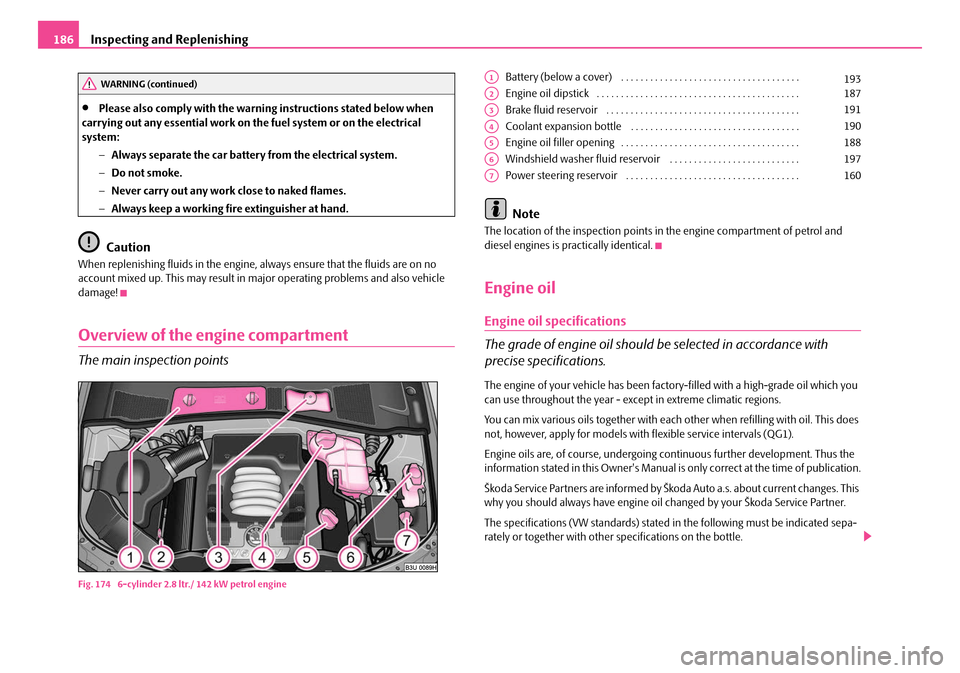
Inspecting and Replenishing
186
•Please also comply with the warnin g instructions stated below when
carrying out any essential work on the fuel system or on the electrical
system:
−Always separate the car batter y from the electrical system.
− Do not smoke.
− Never carry out any work close to naked flames.
− Always keep a working fire extinguisher at hand.
Caution
When replenishing fluids in the engine, always ensure that the fluids are on no
account mixed up. This may result in major operating problems and also vehicle
damage!
Overview of the engine compartment
The main inspection points
Fig. 174 6-cylinder 2.8 ltr./ 142 kW petrol engine
Battery (below a cover) . . . . . . . . . . . . . . . . . . . . . . . . . . . . . . . . . . . . .
Engine oil dipstick . . . . . . . . . . . . . . . . . . . . . . . . . . . . . . . . . . . . . . . . . .
Brake fluid reservoir . . . . . . . . . . . . . . . . . . . . . . . . . . . . . . . . . . . . . . . .
Coolant expansion bottle . . . . . . . . . . . . . . . . . . . . . . . . . . . . . . . . . . .
Engine oil filler opening . . . . . . . . . . . . . . . . . . . . . . . . . . . . . . . . . . . . .
Windshield washer fluid reservoir . . . . . . . . . . . . . . . . . . . . . . . . . . .
Power steering reservoir . . . . . . . . . . . . . . . . . . . . . . . . . . . . . . . . . . . .
Note
The location of the inspection points in the engine compartment of petrol and
diesel engines is practically identical.
Engine oil
Engine oil specifications
The grade of engine oil should be selected in accordance with
precise specifications.
The engine of your vehicle has been factor y-filled with a high-grade oil which you
can use throughout the year - except in extreme climatic regions.
You can mix various oils together with each other when refilling with oil. This does
not, however, apply for models with flexible service intervals (QG1).
Engine oils are, of course, undergoing co ntinuous further development. Thus the
information stated in this Owner's Manual is only correct at the time of publication.
Škoda Service Partners are informed by Škoda Auto a.s. about current changes. This
why you should always have engine oil changed by your Škoda Service Partner.
The specifications (VW standards) stated in the following must be indicated sepa-
rately or together with other specifications on the bottle.
WARNING (continued)A1193A2187
A3191
A4190
A5188
A6197
A7160
NKO B5 20.book Page 186 Friday, March 2, 2007 1:46 PM
Page 190 of 259
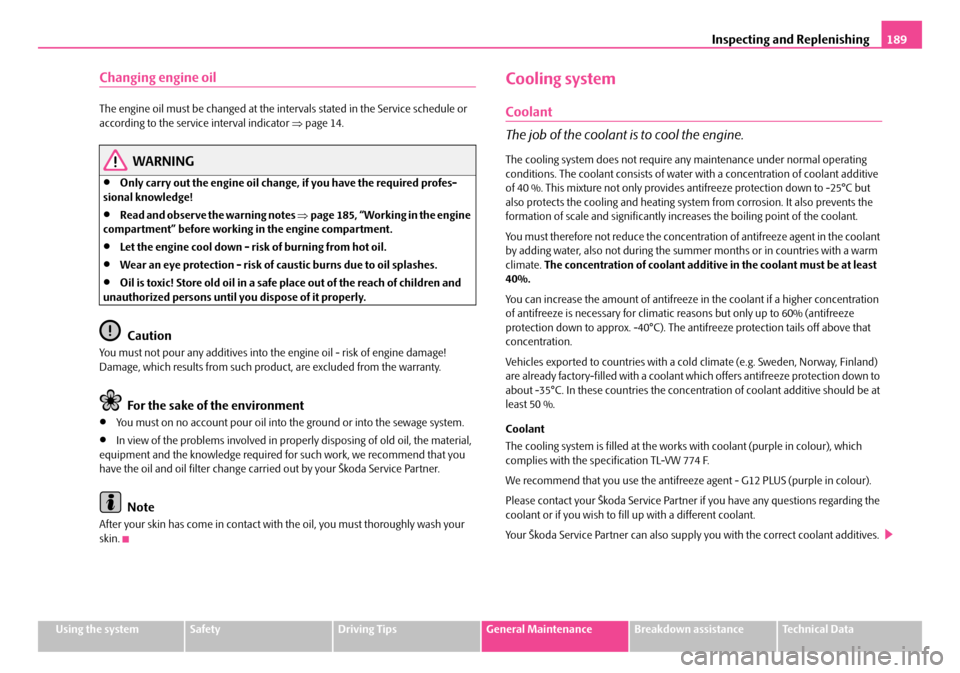
Inspecting and Replenishing189
Using the systemSafetyDriving TipsGeneral MaintenanceBreakdown assistanceTechnical Data
Changing engine oil
The engine oil must be changed at the intervals stated in the Service schedule or
according to the service interval indicator ⇒page 14.
WARNING
•Only carry out the engine oil change, if you have the required profes-
sional knowledge!
•Read and observe the warning notes ⇒page 185, “Working in the engine
compartment” before working in the engine compartment.
•Let the engine cool down - risk of burning from hot oil.
•Wear an eye protection - risk of caustic burns due to oil splashes.
•Oil is toxic! Store old oil in a safe place out of the reach of children and
unauthorized persons until you dispose of it properly.
Caution
You must not pour any additives into th e engine oil - risk of engine damage!
Damage, which results from such produc t, are excluded from the warranty.
For the sake of the environment
•You must on no account pour oil into the ground or into the sewage system.
•In view of the problems involved in prop erly disposing of old oil, the material,
equipment and the knowledge required for such work, we recommend that you
have the oil and oil filter change carried out by your Škoda Service Partner.
Note
After your skin has come in contact with the oil, you must thoroughly wash your
skin.
Cooling system
Coolant
The job of the coolant is to cool the engine.
The cooling system does not require an y maintenance under normal operating
conditions. The coolant consist s of water with a concentration of coolant additive
of 40 %. This mixture not only provides antifreeze protection down to -25°C but
also protects the cooling and heating system from corrosion. It also prevents the
formation of scale and significantly increases the boiling point of the coolant.
You must therefore not reduce the concentration of antifreeze agent in the coolant
by adding water, also not during the su mmer months or in countries with a warm
climate. The concentration of coolant additive in the coolant must be at least
40%.
You can increase the amount of antifreeze in the coolant if a higher concentration
of antifreeze is necessary for climatic reasons but only up to 60% (antifreeze
protection down to approx. -40°C). The an tifreeze protection tails off above that
concentration.
Vehicles exported to countries with a co ld climate (e.g. Sweden, Norway, Finland)
are already factory-filled with a coolant which offers antifreeze protection down to
about -35°C. In these countries the concentr ation of coolant additive should be at
least 50 %.
Coolant
The cooling system is filled at the works with coolant (purple in colour), which
complies with the specification TL-VW 774 F.
We recommend that you use the antifreeze agent - G12 PLUS (purple in colour).
Please contact your Škoda Se rvice Partner if you have any questions regarding the
coolant or if you wish to fill up with a different coolant.
Your Škoda Service Partner can also suppl y you with the correct coolant additives.
NKO B5 20.book Page 189 Friday, March 2, 2007 1:46 PM
Page 191 of 259
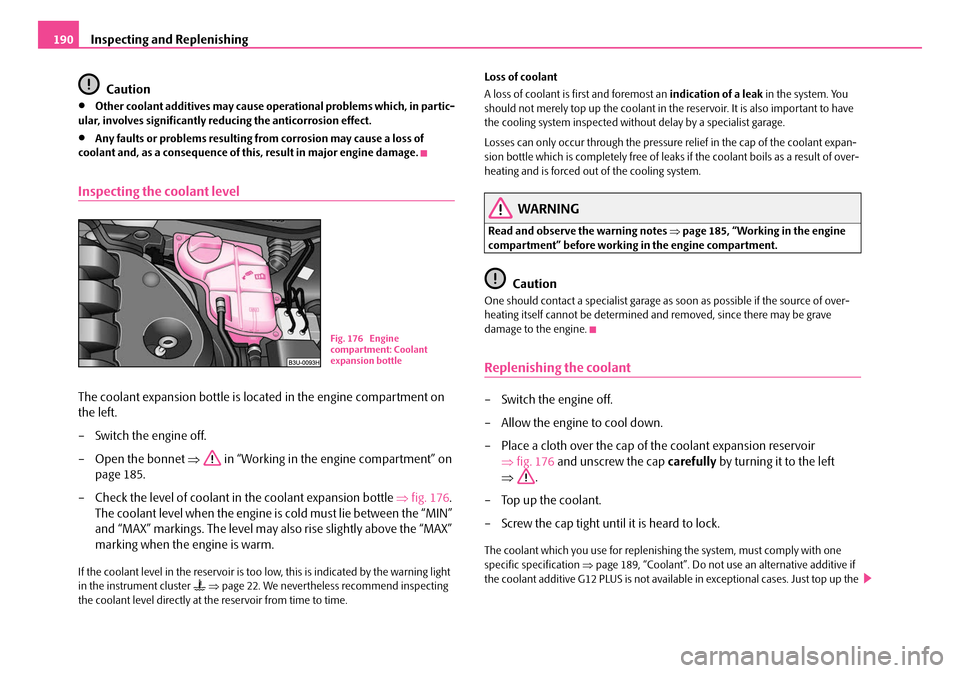
Inspecting and Replenishing
190
Caution
•Other coolant additives may cause operational problems which, in partic-
ular, involves significantly reducing the anticorrosion effect.
•Any faults or problems resulting from corrosion may cause a loss of
coolant and, as a consequence of th is, result in major engine damage.
Inspecting the coolant level
The coolant expansion bottle is located in the engine compartment on
the left.
– Switch the engine off.
– Open the bonnet ⇒ in “Working in the engine compartment” on
page 185.
– Check the level of coolant in the coolant expansion bottle ⇒fig. 176 .
The coolant level when the engine is cold must lie between the “MIN”
and “MAX” markings. The level may also rise slightly above the “MAX”
marking when the engine is warm.
If the coolant level in the reservoir is too low, this is indicated by the warning light
in the instrument cluster ⇒ page 22. We nevertheless recommend inspecting
the coolant level directly at th e reservoir from time to time. Loss of coolant
A loss of coolant is first and foremost an
indication of a leak in the system. You
should not merely top up the coolant in the reservoir. It is also important to have
the cooling system inspected without delay by a specialist garage.
Losses can only occur through the pressure relief in the cap of the coolant expan-
sion bottle which is completely free of leaks if the coolant boils as a result of over-
heating and is forced out of the cooling system.
WARNING
Read and observe the warning notes ⇒page 185, “Working in the engine
compartment” before working in the engine compartment.
Caution
One should contact a specialist garage as soon as possible if the source of over-
heating itself cannot be determined and removed, since there may be grave
damage to the engine.
Replenishing the coolant
– Switch the engine off.
– Allow the engine to cool down.
– Place a cloth over the cap of the coolant expansion reservoir ⇒fig. 176 and unscrew the cap carefully by turning it to the left
⇒ .
– Top up the coolant.
– Screw the cap tight until it is heard to lock.
The coolant which you use for replenishing the system, must comply with one
specific specification ⇒page 189, “Coolant”. Do not use an alternative additive if
the coolant additive G12 PLUS is not available in exceptional cases. Just top up the
B1Z-0042HB1Z-0042H
Fig. 176 Engine
compartment: Coolant
expansion bottle
NKO B5 20.book Page 190 Friday, March 2, 2007 1:46 PM
Page 192 of 259
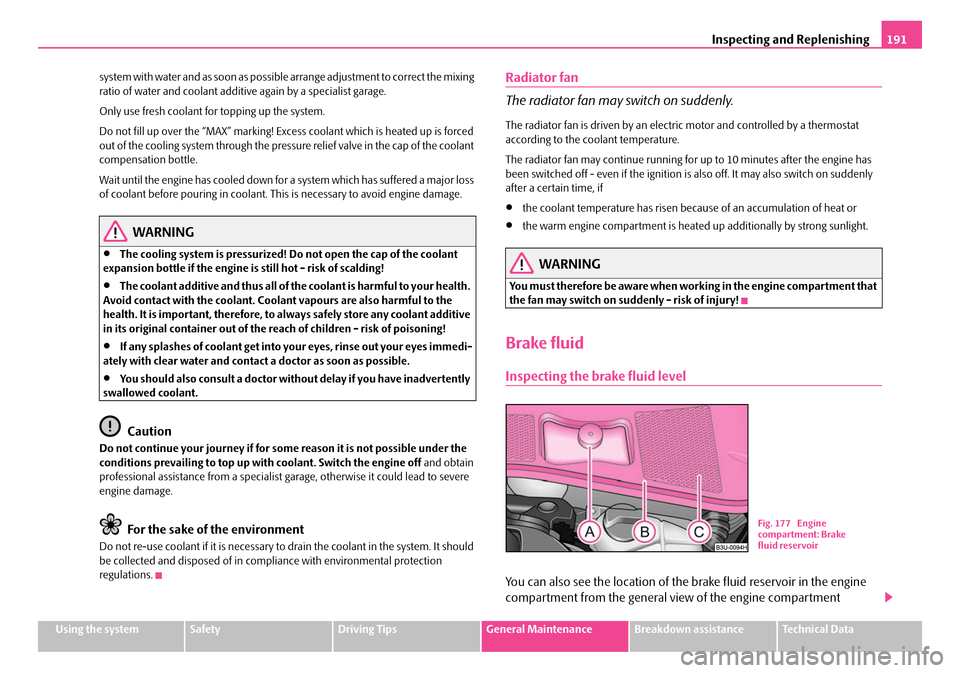
Inspecting and Replenishing191
Using the systemSafetyDriving TipsGeneral MaintenanceBreakdown assistanceTechnical Data
system with water and as soon as possible arrange adjustment to correct the mixing
ratio of water and coolant additive again by a specialist garage.
Only use fresh coolant for topping up the system.
Do not fill up over the “MAX” marking! Exce
ss coolant which is heated up is forced
out of the cooling system through the pressu re relief valve in the cap of the coolant
compensation bottle.
Wait until the engine has cooled down for a system which has suffered a major loss
of coolant before pouring in coolant. Th is is necessary to avoid engine damage.
WARNING
•The cooling system is pressurized! Do not open the cap of the coolant
expansion bottle if the engine is still hot - risk of scalding!
•The coolant additive and thus all of the coolant is harmful to your health.
Avoid contact with the coolant. Coolant vapours are also harmful to the
health. It is important, therefore, to always safely store any coolant additive
in its original container out of the reach of children - risk of poisoning!
•If any splashes of coolant get into yo ur eyes, rinse out your eyes immedi-
ately with clear water and contact a doctor as soon as possible.
•You should also consult a doctor without delay if you have inadvertently
swallowed coolant.
Caution
Do not continue your journey if for some reason it is not possible under the
conditions prevailing to top up with coolant. Switch the engine off and obtain
professional assistance from a specialist garage, otherwise it could lead to severe
engine damage.
For the sake of the environment
Do not re-use coolant if it is necessary to drain the coolant in the system. It should
be collected and disposed of in comp liance with environmental protection
regulations.
Radiator fan
The radiator fan may switch on suddenly.
The radiator fan is driven by an electr ic motor and controlled by a thermostat
according to the coolant temperature.
The radiator fan may conti nue running for up to 10 mi nutes after the engine has
been switched off - even if the ignition is also off. It may also switch on suddenly
after a certain time, if
•the coolant temperature has risen because of an accumulation of heat or
•the warm engine compartmen t is heated up additionally by strong sunlight.
WARNING
You must therefore be aware when working in the engine compartment that
the fan may switch on suddenly - risk of injury!
Brake fluid
Inspecting the brake fluid level
You can also see the location of the brake fluid reservoir in the engine
compartment from the general view of the engine compartment
B1Z-0042HB1Z-0042H
Fig. 177 Engine
compartment: Brake
fluid reservoir
NKO B5 20.book Page 191 Friday, March 2, 2007 1:46 PM
Page 251 of 259
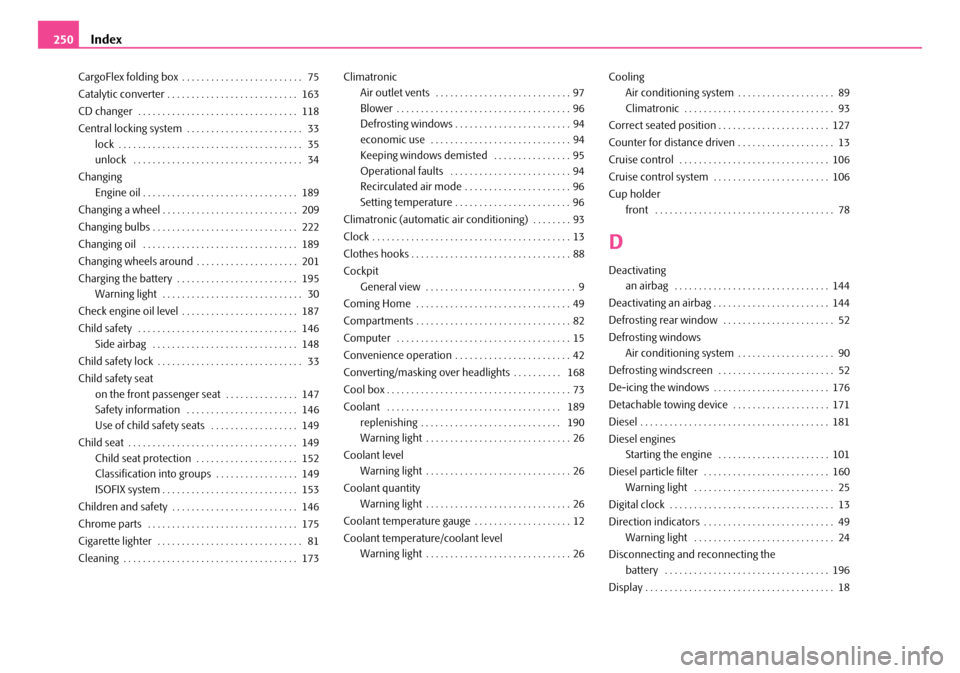
Index
250
CargoFlex folding box . . . . . . . . . . . . . . . . . . . . . . . . . 75
Catalytic converter . . . . . . . . . . . . . . . . . . . . . . . . . . . 163
CD changer . . . . . . . . . . . . . . . . . . . . . . . . . . . . . . . . . 118
Central locking system . . . . . . . . . . . . . . . . . . . . . . . . 33
lock . . . . . . . . . . . . . . . . . . . . . . . . . . . . . . . . . . . . . . 35
unlock . . . . . . . . . . . . . . . . . . . . . . . . . . . . . . . . . . . 34
Changing Engine oil . . . . . . . . . . . . . . . . . . . . . . . . . . . . . . . . 189
Changing a wheel . . . . . . . . . . . . . . . . . . . . . . . . . . . . 209
Changing bulbs . . . . . . . . . . . . . . . . . . . . . . . . . . . . . . 222
Changing oil . . . . . . . . . . . . . . . . . . . . . . . . . . . . . . . . 189
Changing wheels around . . . . . . . . . . . . . . . . . . . . . 201
Charging the battery . . . . . . . . . . . . . . . . . . . . . . . . . 195 Warning light . . . . . . . . . . . . . . . . . . . . . . . . . . . . . 30
Check engine oil level . . . . . . . . . . . . . . . . . . . . . . . . 187
Child safety . . . . . . . . . . . . . . . . . . . . . . . . . . . . . . . . . 146 Side airbag . . . . . . . . . . . . . . . . . . . . . . . . . . . . . . 148
Child safety lock . . . . . . . . . . . . . . . . . . . . . . . . . . . . . . 33
Child safety seat on the front passenger seat . . . . . . . . . . . . . . . 147
Safety information . . . . . . . . . . . . . . . . . . . . . . . 146
Use of child safety seats . . . . . . . . . . . . . . . . . . 149
Child seat . . . . . . . . . . . . . . . . . . . . . . . . . . . . . . . . . . . 149 Child seat protection . . . . . . . . . . . . . . . . . . . . . 152
Classification into groups . . . . . . . . . . . . . . . . . 149
ISOFIX system . . . . . . . . . . . . . . . . . . . . . . . . . . . . 153
Children and safety . . . . . . . . . . . . . . . . . . . . . . . . . . 146
Chrome parts . . . . . . . . . . . . . . . . . . . . . . . . . . . . . . . 175
Cigarette lighter . . . . . . . . . . . . . . . . . . . . . . . . . . . . . . 81
Cleaning . . . . . . . . . . . . . . . . . . . . . . . . . . . . . . . . . . . . 173 Climatronic
Air outlet vents . . . . . . . . . . . . . . . . . . . . . . . . . . . . 97
Blower . . . . . . . . . . . . . . . . . . . . . . . . . . . . . . . . . . . . 96
Defrosting windows . . . . . . . . . . . . . . . . . . . . . . . . 94
economic use . . . . . . . . . . . . . . . . . . . . . . . . . . . . . 94
Keeping windows demisted . . . . . . . . . . . . . . . . 95
Operational faults . . . . . . . . . . . . . . . . . . . . . . . . . 94
Recirculated air mode . . . . . . . . . . . . . . . . . . . . . . 96
Setting temperature . . . . . . . . . . . . . . . . . . . . . . . . 96
Climatronic (automatic air co nditioning) . . . . . . . . 93
Clock . . . . . . . . . . . . . . . . . . . . . . . . . . . . . . . . . . . . . . . . . 13
Clothes hooks . . . . . . . . . . . . . . . . . . . . . . . . . . . . . . . . . 88
Cockpit General view . . . . . . . . . . . . . . . . . . . . . . . . . . . . . . . 9
Coming Home . . . . . . . . . . . . . . . . . . . . . . . . . . . . . . . . 49
Compartments . . . . . . . . . . . . . . . . . . . . . . . . . . . . . . . . 82
Computer . . . . . . . . . . . . . . . . . . . . . . . . . . . . . . . . . . . . 15
Convenience operation . . . . . . . . . . . . . . . . . . . . . . . . 42
Converting/masking over headlights . . . . . . . . . . 168
Cool box . . . . . . . . . . . . . . . . . . . . . . . . . . . . . . . . . . . . . . 73
Coolant . . . . . . . . . . . . . . . . . . . . . . . . . . . . . . . . . . . . 189 replenishing . . . . . . . . . . . . . . . . . . . . . . . . . . . . . 190
Warning light . . . . . . . . . . . . . . . . . . . . . . . . . . . . . . 26
Coolant level Warning light . . . . . . . . . . . . . . . . . . . . . . . . . . . . . . 26
Coolant quantity Warning light . . . . . . . . . . . . . . . . . . . . . . . . . . . . . . 26
Coolant temperature gauge . . . . . . . . . . . . . . . . . . . . 12
Coolant temperatur e/coolant level
Warning light . . . . . . . . . . . . . . . . . . . . . . . . . . . . . . 26 Cooling
Air conditioning system . . . . . . . . . . . . . . . . . . . . 89
Climatronic . . . . . . . . . . . . . . . . . . . . . . . . . . . . . . . 93
Correct seated position . . . . . . . . . . . . . . . . . . . . . . . 127
Counter for distance driven . . . . . . . . . . . . . . . . . . . . 13
Cruise control . . . . . . . . . . . . . . . . . . . . . . . . . . . . . . . 106
Cruise control system . . . . . . . . . . . . . . . . . . . . . . . . 106
Cup holder front . . . . . . . . . . . . . . . . . . . . . . . . . . . . . . . . . . . . . 78
D
Deactivatingan airbag . . . . . . . . . . . . . . . . . . . . . . . . . . . . . . . . 144
Deactivating an airbag . . . . . . . . . . . . . . . . . . . . . . . . 144
Defrosting rear window . . . . . . . . . . . . . . . . . . . . . . . 52
Defrosting windows Air conditioning system . . . . . . . . . . . . . . . . . . . . 90
Defrosting windscreen . . . . . . . . . . . . . . . . . . . . . . . . 52
De-icing the windows . . . . . . . . . . . . . . . . . . . . . . . . 176
Detachable towing device . . . . . . . . . . . . . . . . . . . . 171
Diesel . . . . . . . . . . . . . . . . . . . . . . . . . . . . . . . . . . . . . . . 181
Diesel engines Starting the engine . . . . . . . . . . . . . . . . . . . . . . . 101
Diesel particle filter . . . . . . . . . . . . . . . . . . . . . . . . . . 160 Warning light . . . . . . . . . . . . . . . . . . . . . . . . . . . . . 25
Digital clock . . . . . . . . . . . . . . . . . . . . . . . . . . . . . . . . . . 13
Direction indicators . . . . . . . . . . . . . . . . . . . . . . . . . . . 49 Warning light . . . . . . . . . . . . . . . . . . . . . . . . . . . . . 24
Disconnecting and reconnecting the battery . . . . . . . . . . . . . . . . . . . . . . . . . . . . . . . . . . 196
Display . . . . . . . . . . . . . . . . . . . . . . . . . . . . . . . . . . . . . . . 18
NKO B5 20.book Page 250 Friday, March 2, 2007 1:46 PM